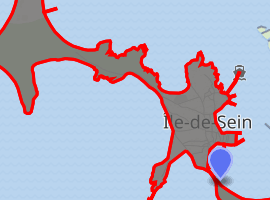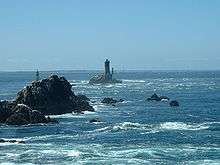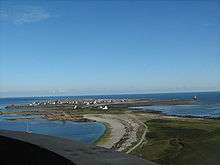Île de Sein
The Île de Sein is a Breton island in the Atlantic Ocean, off Finistère, eight kilometres from the Pointe du Raz (raz meaning "water current"), from which it is separated by the Raz de Sein. Its Breton name is Enez Sun. The island, with its neighbouring islets, forms the commune of Île-de-Sein in the Finistère department of Brittany in north-western France. Inhabitants of Île-de-Sein are called in French Sénans.
Île-de-Sein Enez-Sun | |
|---|---|
 Close-up of the island | |
Location of Île-de-Sein 
| |
 Île-de-Sein  Île-de-Sein | |
| Coordinates: 48°02′12″N 4°50′58″W | |
| Country | France |
| Region | Brittany |
| Department | Finistère |
| Arrondissement | Quimper |
| Canton | Douarnenez |
| Government | |
| • Mayor (2014–2020) | Dominique Salvert |
| Area 1 | 0.58 km2 (0.22 sq mi) |
| Population (2008) | 214 |
| • Density | 370/km2 (960/sq mi) |
| Time zone | UTC+01:00 (CET) |
| • Summer (DST) | UTC+02:00 (CEST) |
| INSEE/Postal code | 29083 /29990 |
| Elevation | 0–9 m (0–30 ft) |
| 1 French Land Register data, which excludes lakes, ponds, glaciers > 1 km2 (0.386 sq mi or 247 acres) and river estuaries. | |



Lying on the sea routes going south from the English Channel, Sein is well known for the dangers of its waters, the Chaussée de Sein, a vast zone of reefs stretching more than 30 miles from east to west, requiring numerous lighthouses, beacons, and buoys. The lighthouses near the reef include Ar Men, La Vieille and Tévennec.
History
There are two megalithic menhirs on the island, which is flat and treeless.[1]
It is mentioned by the Roman geographer Pomponius Mela.[1]
The island women used to wear a black headdress, and in the past, they had a reputation for enticing sailors onto the rocks by witchcraft. In the past, it was also known for its wreckers.[2]
During World War II, German forces occupied the island. The Île de Sein lighthouse (Le Phare de Goulenez) at the western end was destroyed - it was later rebuilt in 1952. After hearing General de Gaulle's call to resistance during World War II in his appeal to the French on 18 June 1940, every male inhabitant aged between 14 and 54 (or 60, according to the island's official website[3]) (variously totalled as 114 to 128) set sail in their fishing boats for Britain to join the Free French forces. For this, on 1 January 1946, the community was awarded the high honour of the Order of the Liberation.
During the 1960s, French artists Maurice Boitel and Jean Rigaud painted on the Île de Sein.
It is featured in the 1995 French film Élisa.
Legend
According to Breton legend, Île de Sein was once home to a group of virgin druid priestesses called the Gallizenae. They are said to have had the power to predict the future, to calm the winds, and to take the forms of different animals.[4]
The writer Robert Graves says that the island was once home to a conclave of nine virgin priestesses believed to hold magical powers, who might be approached by those who sailed to consult them.[1]
Further reading
- Queffélec, Henri, Un recteur de l'île de Sein, Éditions Bartillat, Paris, 1999, ISBN 2841001210
External links
![]()
- French Ministry of Culture list for Île-de-Sein (in French)
- (in French) State Lighthouse "la VIEILLE" dated April 19, 2009
- (in French) State Lighthouse "Enez-Sun" dated April 19, 2009
- île de Sein's dolphins on YouTube
- Having defied the Nazis,Islanders take on the sea 23. July.2012 The New York Times
References
- Graves, Robert (1961). The White Goddess. London: Faber & Faber. p. 111. ISBN 0-571-06961-4.
- Île de Sein is known for wreckers. (phrase search) – via Google Books.
- "Site officiel de l'ile de Sein". Retrieved 25 September 2014.
- "Gallizenae - Oxford Reference". oxfordreference.com.
- INSEE
- Mayors of Finistère Association (in French)